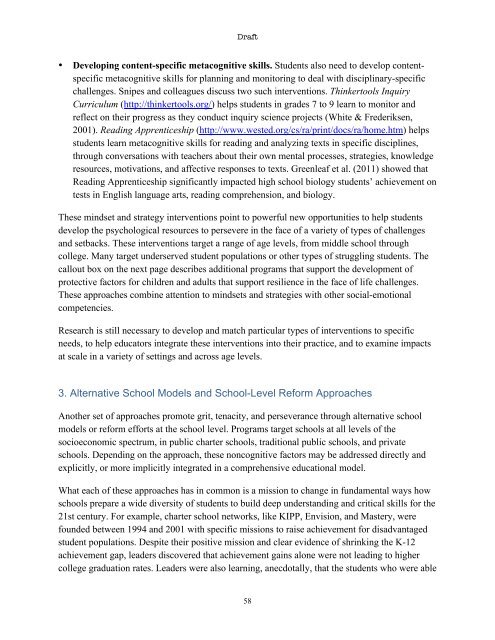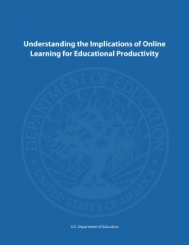Promoting Grit, Tenacity, and Perseverance - U.S. Department of ...
Promoting Grit, Tenacity, and Perseverance - U.S. Department of ...
Promoting Grit, Tenacity, and Perseverance - U.S. Department of ...
You also want an ePaper? Increase the reach of your titles
YUMPU automatically turns print PDFs into web optimized ePapers that Google loves.
Draft<br />
• Developing content-specific metacognitive skills. Students also need to develop contentspecific<br />
metacognitive skills for planning <strong>and</strong> monitoring to deal with disciplinary-specific<br />
challenges. Snipes <strong>and</strong> colleagues discuss two such interventions. Thinkertools Inquiry<br />
Curriculum (http://thinkertools.org/) helps students in grades 7 to 9 learn to monitor <strong>and</strong><br />
reflect on their progress as they conduct inquiry science projects (White & Frederiksen,<br />
2001). Reading Apprenticeship (http://www.wested.org/cs/ra/print/docs/ra/home.htm) helps<br />
students learn metacognitive skills for reading <strong>and</strong> analyzing texts in specific disciplines,<br />
through conversations with teachers about their own mental processes, strategies, knowledge<br />
resources, motivations, <strong>and</strong> affective responses to texts. Greenleaf et al. (2011) showed that<br />
Reading Apprenticeship significantly impacted high school biology students’ achievement on<br />
tests in English language arts, reading comprehension, <strong>and</strong> biology.<br />
These mindset <strong>and</strong> strategy interventions point to powerful new opportunities to help students<br />
develop the psychological resources to persevere in the face <strong>of</strong> a variety <strong>of</strong> types <strong>of</strong> challenges<br />
<strong>and</strong> setbacks. These interventions target a range <strong>of</strong> age levels, from middle school through<br />
college. Many target underserved student populations or other types <strong>of</strong> struggling students. The<br />
callout box on the next page describes additional programs that support the development <strong>of</strong><br />
protective factors for children <strong>and</strong> adults that support resilience in the face <strong>of</strong> life challenges.<br />
These approaches combine attention to mindsets <strong>and</strong> strategies with other social-emotional<br />
competencies.<br />
Research is still necessary to develop <strong>and</strong> match particular types <strong>of</strong> interventions to specific<br />
needs, to help educators integrate these interventions into their practice, <strong>and</strong> to examine impacts<br />
at scale in a variety <strong>of</strong> settings <strong>and</strong> across age levels.<br />
3. Alternative School Models <strong>and</strong> School-Level Reform Approaches<br />
Another set <strong>of</strong> approaches promote grit, tenacity, <strong>and</strong> perseverance through alternative school<br />
models or reform efforts at the school level. Programs target schools at all levels <strong>of</strong> the<br />
socioeconomic spectrum, in public charter schools, traditional public schools, <strong>and</strong> private<br />
schools. Depending on the approach, these noncognitive factors may be addressed directly <strong>and</strong><br />
explicitly, or more implicitly integrated in a comprehensive educational model.<br />
What each <strong>of</strong> these approaches has in common is a mission to change in fundamental ways how<br />
schools prepare a wide diversity <strong>of</strong> students to build deep underst<strong>and</strong>ing <strong>and</strong> critical skills for the<br />
21st century. For example, charter school networks, like KIPP, Envision, <strong>and</strong> Mastery, were<br />
founded between 1994 <strong>and</strong> 2001 with specific missions to raise achievement for disadvantaged<br />
student populations. Despite their positive mission <strong>and</strong> clear evidence <strong>of</strong> shrinking the K-12<br />
achievement gap, leaders discovered that achievement gains alone were not leading to higher<br />
college graduation rates. Leaders were also learning, anecdotally, that the students who were able<br />
58
















